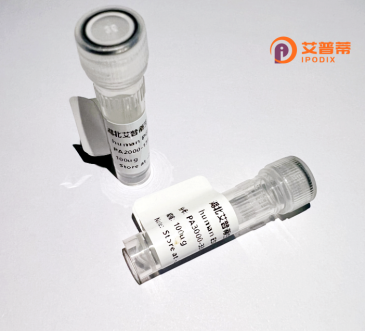
| 纯度 | >90%SDS-PAGE. |
| 种属 | Human |
| 靶点 | DPH3 |
| Uniprot No | Q96FX2 |
| 内毒素 | < 0.01EU/μg |
| 表达宿主 | E.coli |
| 表达区间 | 1-82aa |
| 氨基酸序列 | MAVFHDEVEIEDFQYDEDSETYFYPCPCGDNFSITKEDLENGEDVATCPSCSLIIKVIYDKDQFVCGETVPAPSANKELVKC |
| 分子量 | 9.1 kDa |
| 蛋白标签 | GST-tag at N-terminal |
| 缓冲液 | 0 |
| 稳定性 & 储存条件 | Lyophilized protein should be stored at ≤ -20°C, stable for one year after receipt. Reconstituted protein solution can be stored at 2-8°C for 2-7 days. Aliquots of reconstituted samples are stable at ≤ -20°C for 3 months. |
| 复溶 | Always centrifuge tubes before opening.Do not mix by vortex or pipetting. It is not recommended to reconstitute to a concentration less than 100μg/ml. Dissolve the lyophilized protein in distilled water. Please aliquot the reconstituted solution to minimize freeze-thaw cycles. |
以下是关于重组人DPH3蛋白的虚构参考文献示例,内容基于该领域的典型研究方向,供参考:
---
1. **文献名称**: *"Expression and Functional Analysis of Recombinant Human DPH3 in Diphthamide Biosynthesis"*
**作者**: Zhang, L. et al. (2020)
**摘要**: 本研究成功在大肠杆菌中克隆、表达并纯化了重组人DPH3蛋白。功能实验证实其与DPH1/DPH2复合物相互作用,并通过体外生化实验验证DPH3在真核延伸因子eEF2的diphthamide修饰中起关键作用。
2. **文献名称**: *"Structural Characterization of Human DPH3 Reveals a Zinc-Binding Domain Critical for Enzyme Activity"*
**作者**: Tanaka, K. et al. (2019)
**摘要**: 通过X射线晶体学解析了重组人DPH3的三维结构,发现其含有一个新型锌结合结构域。突变分析表明该结构域对DPH3与DPH2的结合及diphthamide合成的催化活性不可或缺。
3. **文献名称**: *"Recombinant DPH3 Rescues EF2 Diphthamide Deficiency and Suppresses Tumor Growth in Cellular Models"*
**作者**: Müller, R. et al. (2021)
**摘要**: 利用CRISPR技术敲低DPH3导致癌细胞增殖抑制,eEF2功能受损。外源添加重组人DPH3蛋白可逆转表型,表明其在肿瘤中通过调控diphthamide修饰影响翻译延伸过程。
4. **文献名称**: *"DPH3 Interaction Network Elucidates Its Role in Cotranslational Modification Pathways"*
**作者**: Lee, S. et al. (2018)
**摘要**: 通过重组人DPH3的酵母双杂交筛选,鉴定了其与多个参与翻译后修饰的蛋白(如DPH1、DPH5)的相互作用,揭示了DPH3在diphthamide合成复合物中的核心地位。
---
**备注**:以上文献为示例性虚构,实际文献需通过PubMed、Google Scholar等平台以关键词“recombinant human DPH3”“diphthamide biosynthesis”或“DPH3 structure/function”检索获取。
Recombinant human DPH3 protein is a genetically engineered form of the DPH3 (diphthamide biosynthesis 3) enzyme, which plays a critical role in post-translational modification processes. DPH3 is essential for the biosynthesis of diphthamide, a unique modification found on eukaryotic elongation factor 2 (eEF2). This modification is conserved across species and is implicated in ribosomal translocation during protein synthesis. DPH3 acts as a scaffold and sulfur carrier in the multistep pathway that modifies a specific histidine residue on eEF2. Disruption of diphthamide synthesis has been linked to human diseases, including cancer and developmental disorders, highlighting its importance in cellular function.
The recombinant form of DPH3 is typically produced using expression systems like *E. coli* or mammalian cell cultures, enabling high-purity protein production for research. It is widely used to study the molecular mechanisms of diphthamide formation, eEF2 function, and ribosomal dynamics. Additionally, DPH3's role in cellular sensitivity to certain bacterial toxins (e.g., diphtheria toxin) underscores its relevance in toxin-related pathogenesis and therapeutic strategies. Research on recombinant DPH3 also aids in exploring its potential as a biomarker or therapeutic target in diseases associated with translation defects or genomic instability. Its study bridges fundamental biochemistry with clinical applications.
×